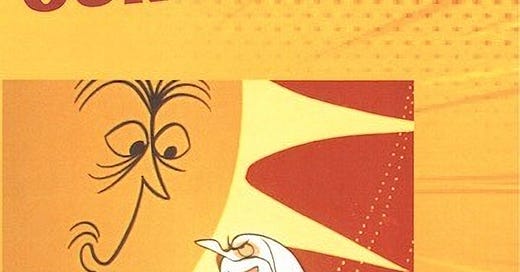Shortly after my eighth birthday, I fell in love with a movie for the first time. Broadcast originally as a television special, and later distributed to classrooms around the world, Our Mr. Sun featured an irresistible combination of entertainment, humor and scientific enlightenment. Friendly, avuncular characters, identified as “Dr. Research” and “The Fiction Writer,” guided the proceedings and provided omniscient sources of information about how our universe actually worked. Animated personalities representing “Father Time” and “Mr. Sun” himself, voiced by veteran Hollywood actors Lionel Barrymore and Marvin Miller, provided their own perspective and additional appeal to young kids like me.
But the one aspect of the hour-long extravaganza that made the deepest impression on my second-grade consciousness involved some of the glorious background music that accompanied all of the informative conversation and stunning documentary footage. I had already started piano and flute lessons and, courtesy of my parents’ collection of 78 RPM records, developed a growing appreciation of Beethoven and Mozart. That meant the classical favorites used in the score, as arranged by a journeyman film composer named Samuel Hoffman, seemed like old friends.
But one selection I’d never heard before, represented Mr. Sun’s triumphant, daily march across the sky to bring light and warmth to our world. With blaring fanfares of trumpets, trombones and French horns, combined with thundering kettle drums, this heroic melody became associated in my mind with everything I loved about the movie. The music’s furious and explosive energy and noble sweep would come to mind for years after that, sometimes associated with my occasional appreciation of sunrises or sunsets, but with no knowledge of where it came from.
Actually, the music originated long before the educational film, composed some 120 years earlier. When I started high school, I became more familiar with the “classical repertoire,” mostly from listening to music stations on the car radio. One afternoon, there it was—the “Our Mr. Sun theme,” but identified by the announcer as the Symphonie Fantastique by Hector Berlioz.
First performed in Paris in 1830, the passage that made such a deep impression on me and lodged so firmly in my memory had nothing to do with the majesty and power of the burning body of gases that illuminates our existence. The Symphonie is actually a wild collection of tortured scenes on the part of a love-drunk artist who imagines seeing, pursuing, and ultimately murdering the indelibly lovely object of his affections. He is ultimately consigned to a hellish “Witches Sabbath,” after he’s been executed for this crime of passion.
The Mr. Sun music that I cherished came from the fourth movement of the Symphonie, entitled “The March to the Scaffold,” meant to depict the final, fateful steps to the guillotine before the ultimate pains of damnation. The musical description that struck me as so indescribably triumphant is more accurately experienced as defiant, with a bold refusal to feel apologetic or guilty as the brass choirs and relentless timpani dramatize the last footsteps to the guillotine.
That vision would have made no connection with my eight-year-old self; it worked much better by stirring my enthusiasm for a friendly cartoon sun, and a wise, good-natured professor (actually the famous Dr. Frank Baxter of USC) explaining the way that modern telescopes have helped illuminate the mysterious realities of our solar system, if not our universe. To this day, whenever I hear the Hector Berlioz masterpiece, I inevitably drift back to recollections of Our Mr. Sun (which they showed several times in our elementary school classes) and, inevitably, recollections of my music-loving and science-loving late parents.
Another random development has recently brought me back to reflections of the Berlioz/”Mr. Sun” melody that continues to haunt me.
A week from now, I’m scheduled to give a lecture at Grove City College in western Pennsylvania, a marvelous liberal arts institution that I’ve visited many times before. On this occasion, the assembled guests (including former Vice President Mike Pence) are scheduled to pay tribute to the great Hollywood director Frank Capra, creator of Mr. Smith Goes to Washington, which, since its 1939 release, has been widely hailed as one of the greatest and most inspiring films to ever dramatize American politics.
In preparing my remarks, I spent some time reconsidering Capra’s career, especially the last thirty years of his long life (he died at 94 in 1991). For complicated reasons, including his growing disillusionment with the Hollywood system that had previously served him so well, he produced few major films in his last four decades, following his beloved masterpiece It’s a Wonderful Life (1946).
But a complete filmography does make the point that he enriched the culture with a masterpiece of a very different sort, even in his long years of semi-retirement. The great Frank Capra wrote, produced and directed Our Mr. Sun in 1956.
That contribution inspired me as a child, and its borrowed music (Merci, Monsieur Berlioz!) still provides me with joy and inspiration. Yes, Capra created some of the greatest achievements in Hollywood history early in his career, but in my estimation, Mr. Sun also rises.




